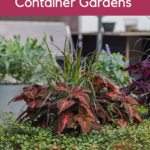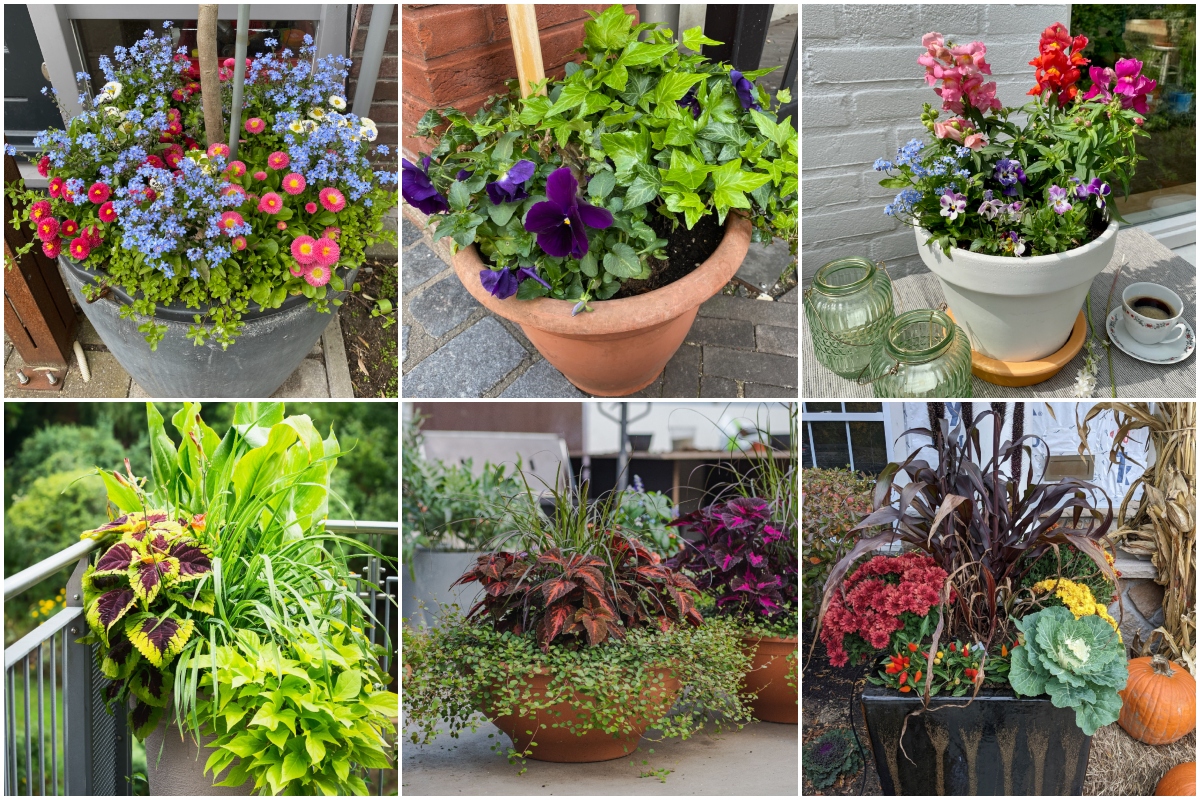
It is a truth universally acknowledged that a gardener in possession of a balcony must be in need of a container arrangement. Or at least this has been my truth for the better part of a decade, as I bounced around rented apartments, rented backyards and community gardens.
Creating container gardens kept me grounded in the truth that I was, at heart, a gardener; even if the patch of soil to call my own resided in a collection of flowerpots strewn about on a fourth floor balcony.
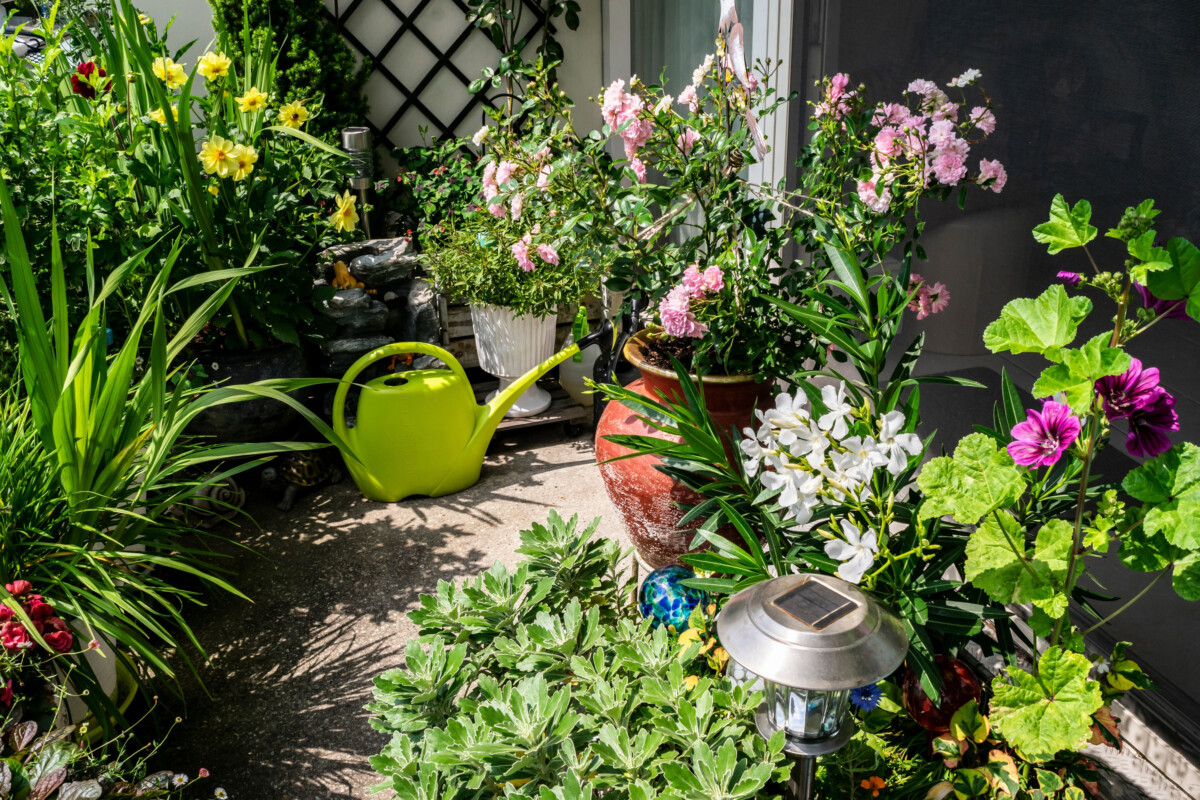
Even now, when I once again have a proper garden to play around in, my love for container gardening still runs deep. I place pots full of flowers wherever I get a tiny bit of space – on my deck, by my front door, along a border, as a privacy screen in front of my kitchen window.
Choosing a pleasant plant combination for my container arrangements is what empowers my creativity and sense of beauty. But I know that it’s not always easy to figure out what to plant in a container garden. That’s why I decided to write about flower pot combinations that make sense in every season. This is not an end-all be-all list, of course. Feel free to use it as a guide to get your own creativity flowing.
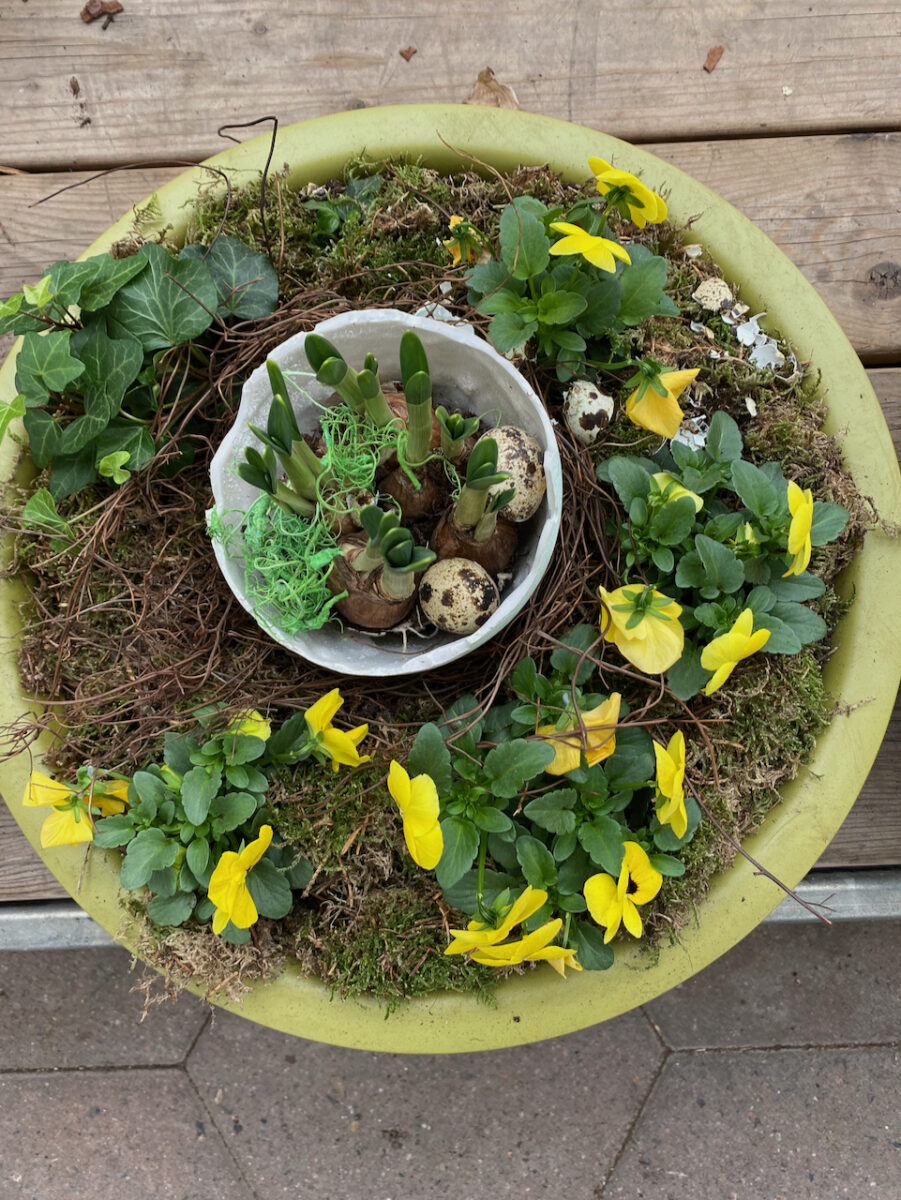
In choosing these container arrangements, I have been mindful of a few factors. I’m including containers that are suitable for small spaces, as well as for a variety of budgets. But I’m also adding some options for gardeners who have a bit more space to fill (and perhaps a bit more money to spend). The plants in these arrangements are not hard to find and, as much as possible, I’ve kept the number of plants below five.
You’ll also notice the same plant on repeat in different formulas. I’m doing this on purpose to show you how one plant can carry over from one season to the next. Once you have it (and know how to take care of it), it’s so easy to move it from one arrangement to another.
5 Plant Combinations for Spring Container Gardens
Velvety repetition: Common daisies and forget-me-nots.
I love this method of filling up a container because, even though there are only technically two types of plants in there (and some forgotten self-seeded chickweed), it looks much fuller than it actually is. This effect is amplified by repeating the same flower in different color variations.
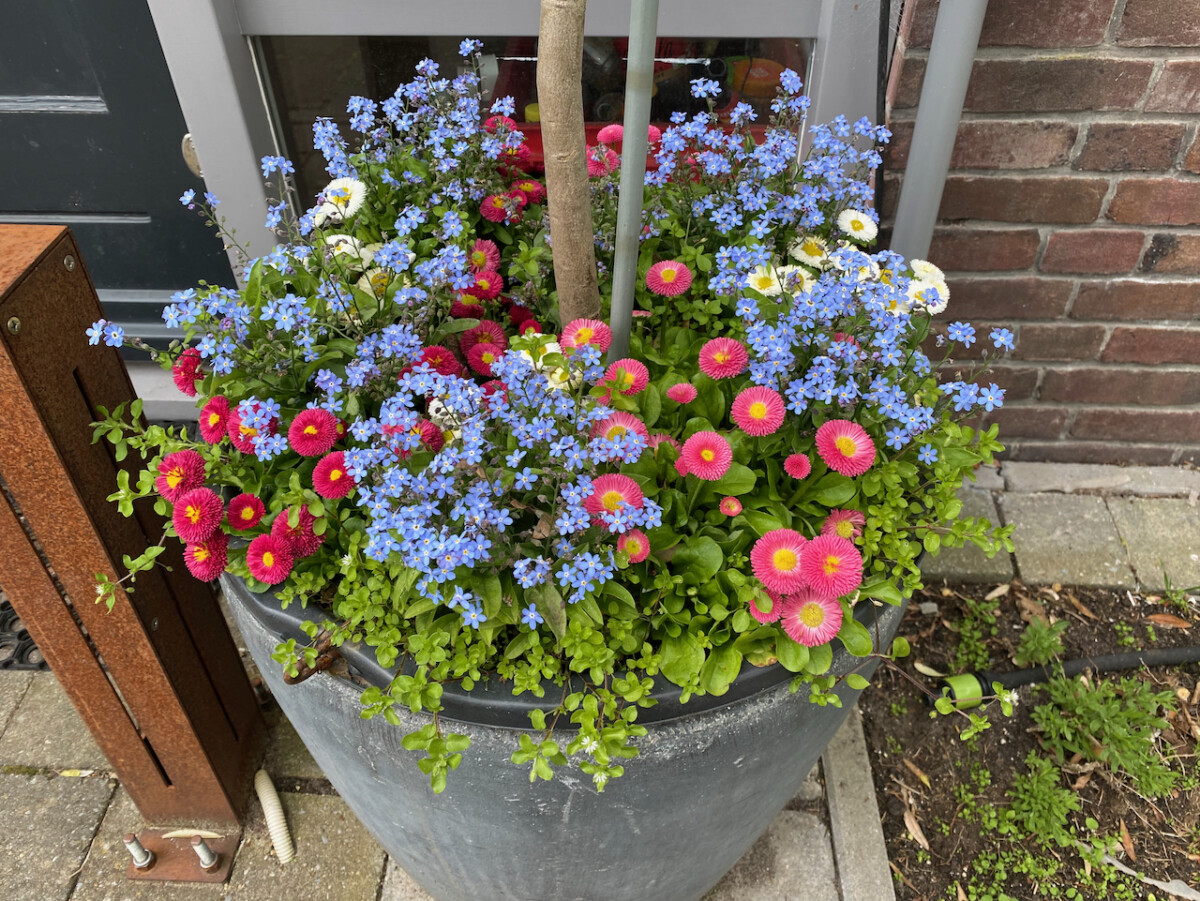
In this case, the common daisy (Belis) shows up in warm hues of fuchsia, bright pink and vanilla white. When you interplant the daisies with the baby blue of forget-me-nots (Myosotis), the velvety texture of the Belis really stands out.
A tabletop rainbow: snapdragons, forget-me-nots and pansies.
I created this container arrangement as a centerpiece for my patio table. I had two goals in mind when I started. First, I knew I wanted a colorful rainbow garden in a container; then I also knew the pot had to be small in order to leave enough room to actually use the table for outdoor lunches when the weather is mild enough.
Inspired by the repeated pattern of the common daisies in the arrangement above, I bought miniature snapdragons (Antirrhinum) in four different warm colors. I then added some wispy forget-me-nots (Myosotis) to tone down the brightness without taking center stage.
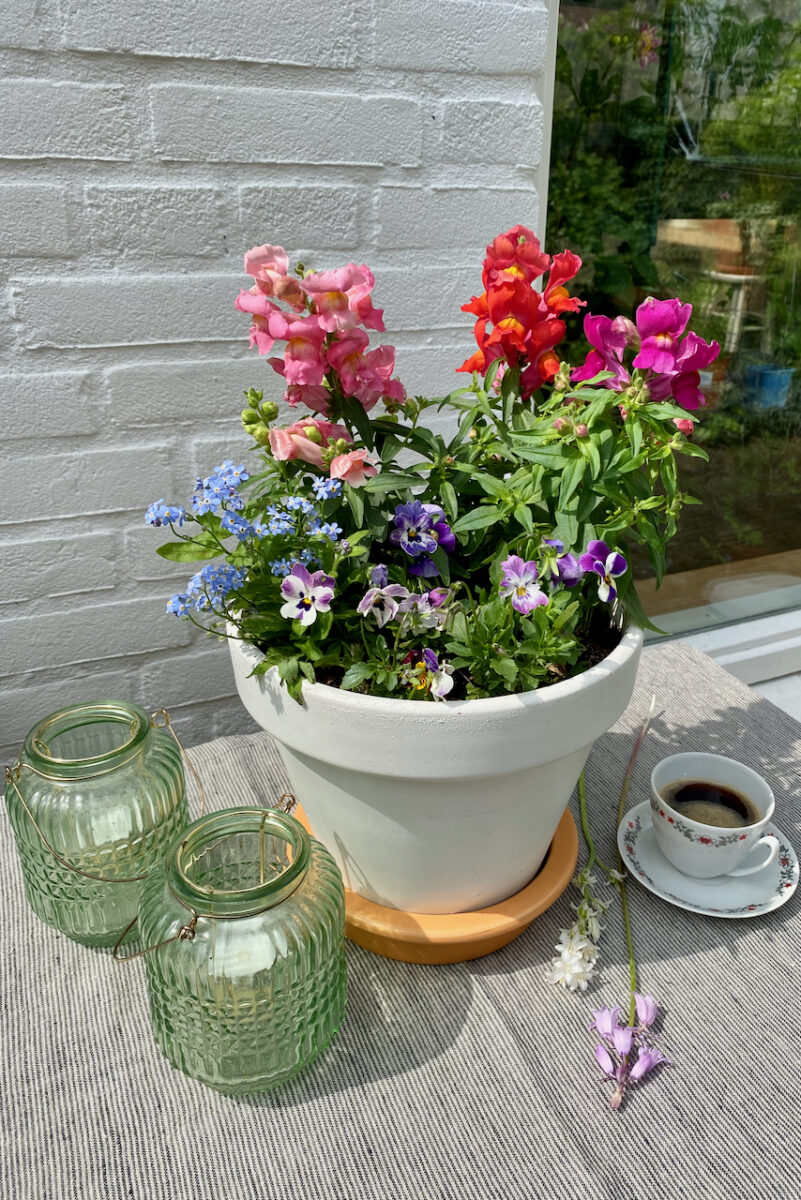
However, I still had a few more colors to go before filling up my rainbow bingo card, but not nearly enough space to play with. So multicolored pansies made their way in from the garden to fulfill the brief.
This is my favorite tip when planting a container arrangement: you don’t always need to start from scratch. Have a look around your garden (or in other containers) and see if there’s anything already growing that you can use. Then gently transplant it (or divide it) and incorporate it into your new design.
Silver linings: Lavender, violas and snowberries.
I don’t know what I like most about this trio. Is it the repetition of containers in the same shape and color? The repetition of the plants? Or the solar-powered pot gnome?
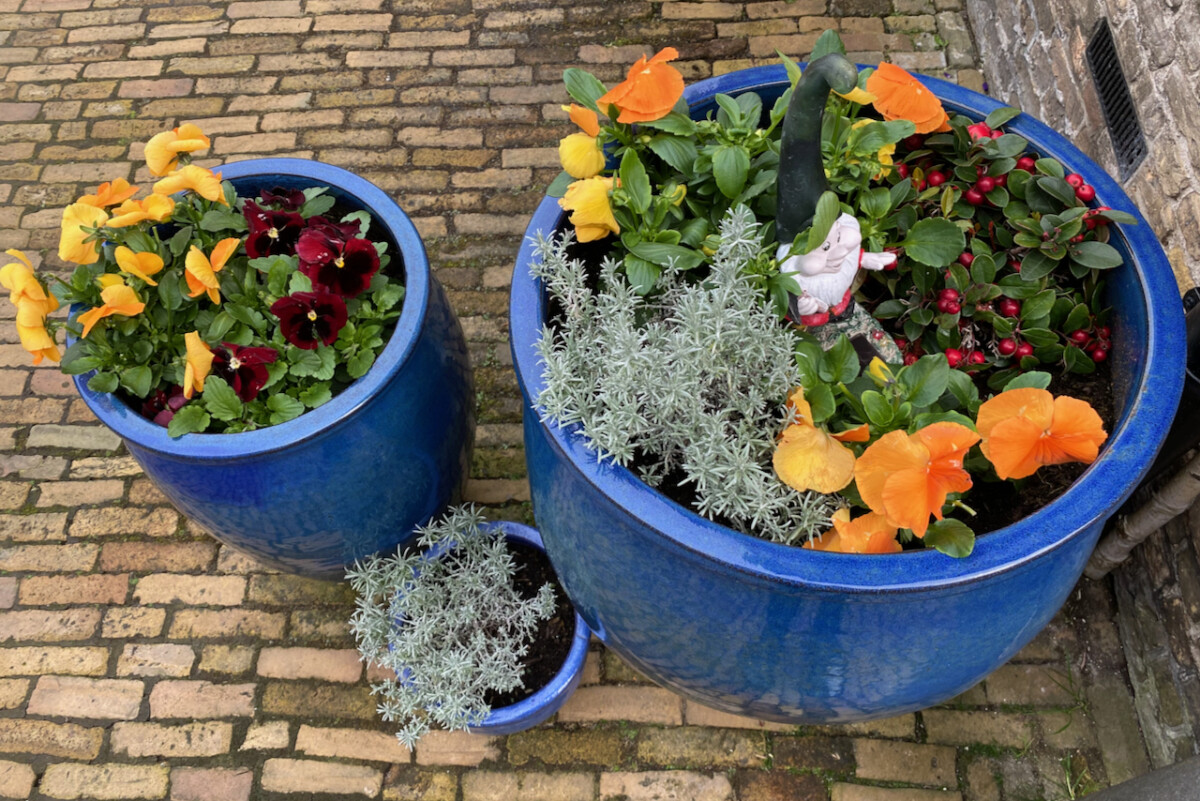
This combination of plants is very smartly done and easy to pull off in mid- to late spring. The lavender – very much a summer plant – is still small enough not to take over. The violas – quintessentially spring flowers – in shades of burgundy and bright orange add a pleasant contrast to the silver foliage of the lavender. But then we still have a surprising remnant of winter in the form of snowberries (Gaultheria).
Three seasons sharing one container is something you don’t see very often.
Chasing away the blues: Muscari, moss and violas.
This is another container combination that works surprisingly well, in spite of its cool shades. It’s the wood of the crate and the texture of the moss underplanting that softens this arrangement.
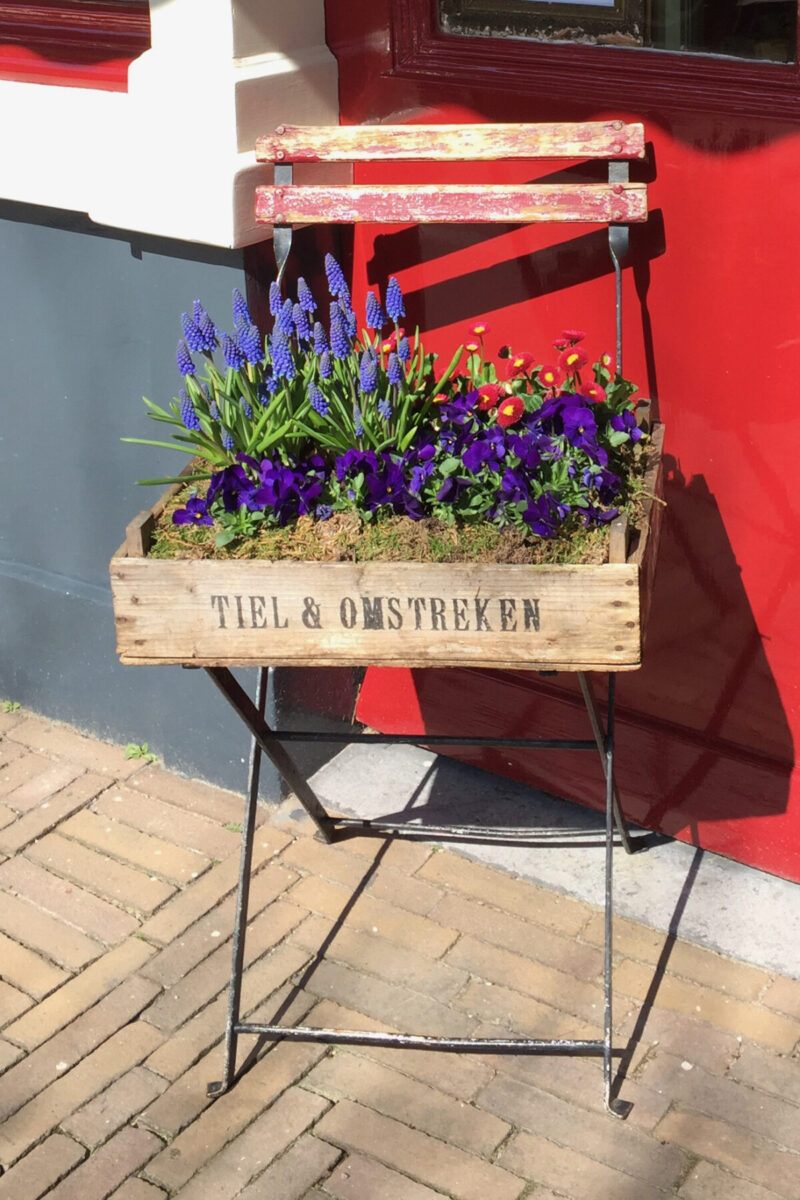
Grape hyacinths (Muscari) are one of the earliest spring bulbs to flower (perhaps second only to snowdrops and aconites). By grouping together their small, colorful heads we amplify the effect and make the container seem more full. Then the trusty violas work as the filler of the display.
Once all the muscari and their foliage are gone and the violas have self-seeded, you can just keep this arrangement as it is for next spring. Store the crate in a cool, dark place over the winter, then pull it back out in January. Both the pansies and the bulbs need about six to eight weeks of cold weather exposure in order to bloom again.
Back to basics: Pansies and English ivy.
This is a very frugal plant pairing if you’re just starting with container gardening. Take any colorful flower that’s in season and add a small English ivy next to it. So for spring, you could pair the English ivy with pansies, bluebells, primroses or daffodils. Once these flowers are past their prime, you could replace them with pincushion flowers (Scabiosa), lantana or petunias in the summer. Rinse and repeat for fall and winter.
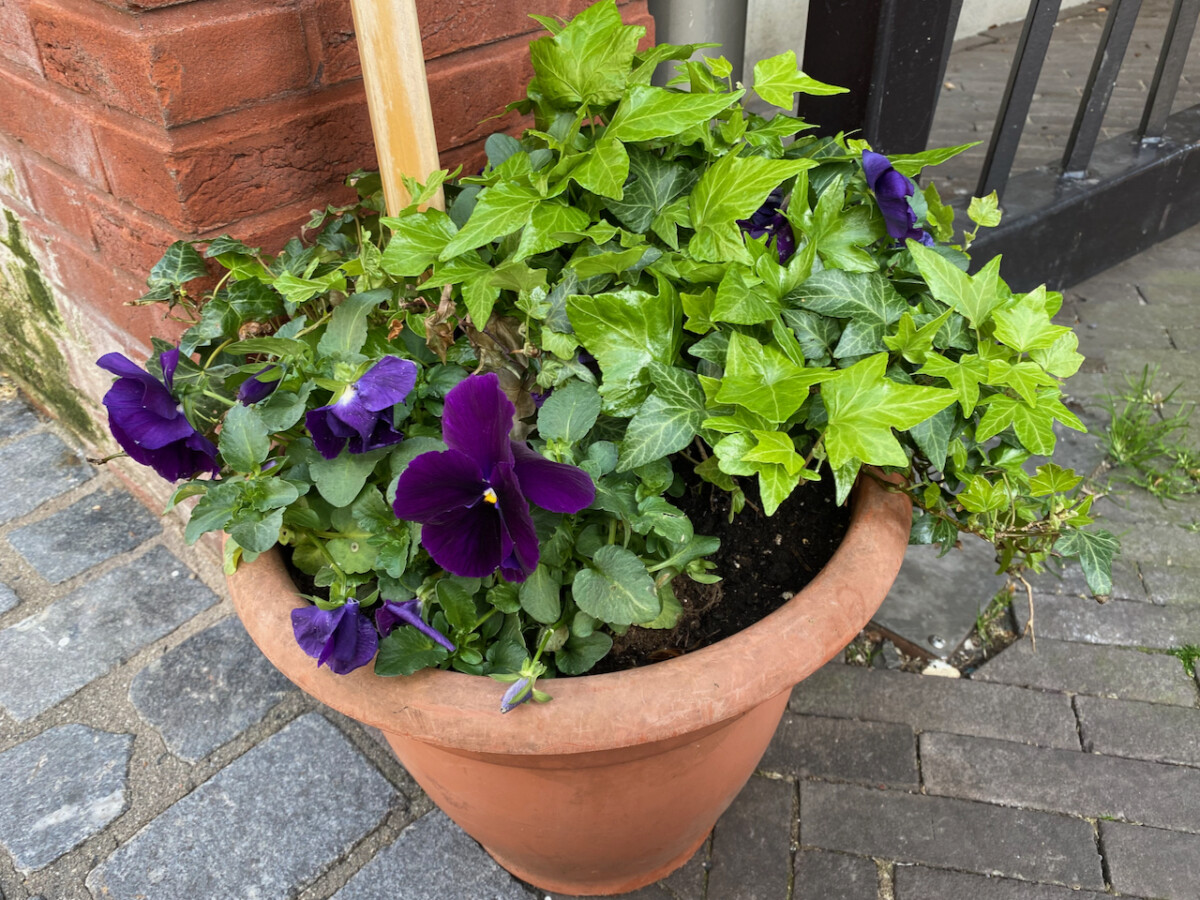
The beauty of the ivy is that it will stay evergreen and act as a background to your seasonal plant combinations. Do be careful with ivy though. It can take over very quickly if you transplant it in the garden, so make sure it stays confined to a container.
5 Plant Combinations for Summer Container Arrangements
Cascading fragrance: Geraniums and more geraniums.
When I think of summer container gardens, my mind instantly goes to window boxes filled with bright red geraniums. Imagine throwing open the windows on a hot summer day to let the scent of geraniums waft in with the breeze. Pure bliss!
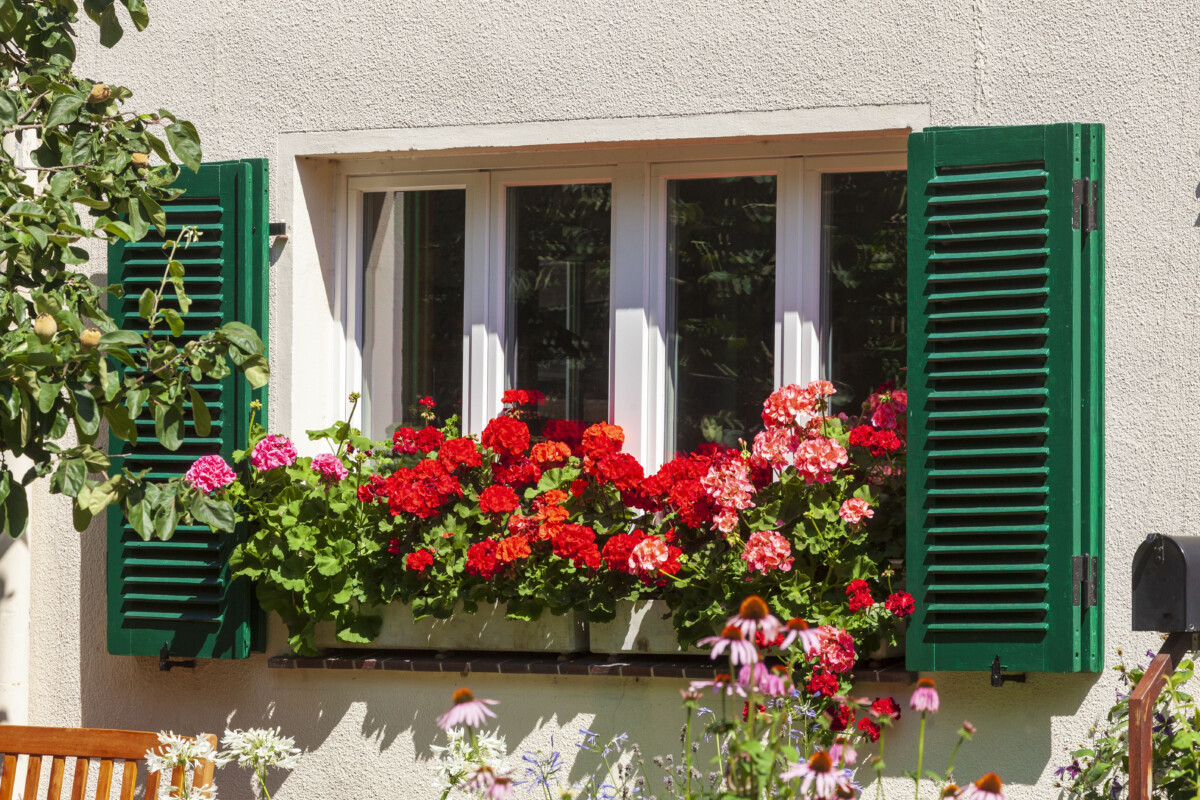
Not only will geraniums handle midsummer heat very well, but they’ll also keep blooming for months as long as you pinch back the dead flowers.
If it’s the classic look you’re after, then deep red geraniums are the way to go. However, I am partial to pink geraniums, or even white ones. By this logic, the best plants to add to a geranium container garden are more geraniums. Green shutters optional!
Layer cake: Grasses, coleus and some creeping Jenny.
You might have heard about the thriller, filler and spiller formula of creating a container display. I’m not a big fan of set formulas myself, but when the filler is the uber-cool coleus, you can count me on board. The thriller (in this case grasses) adds height and texture to the container. And the spiller (creeping Jenny is a good choice) is in charge of giving a sense of flow.
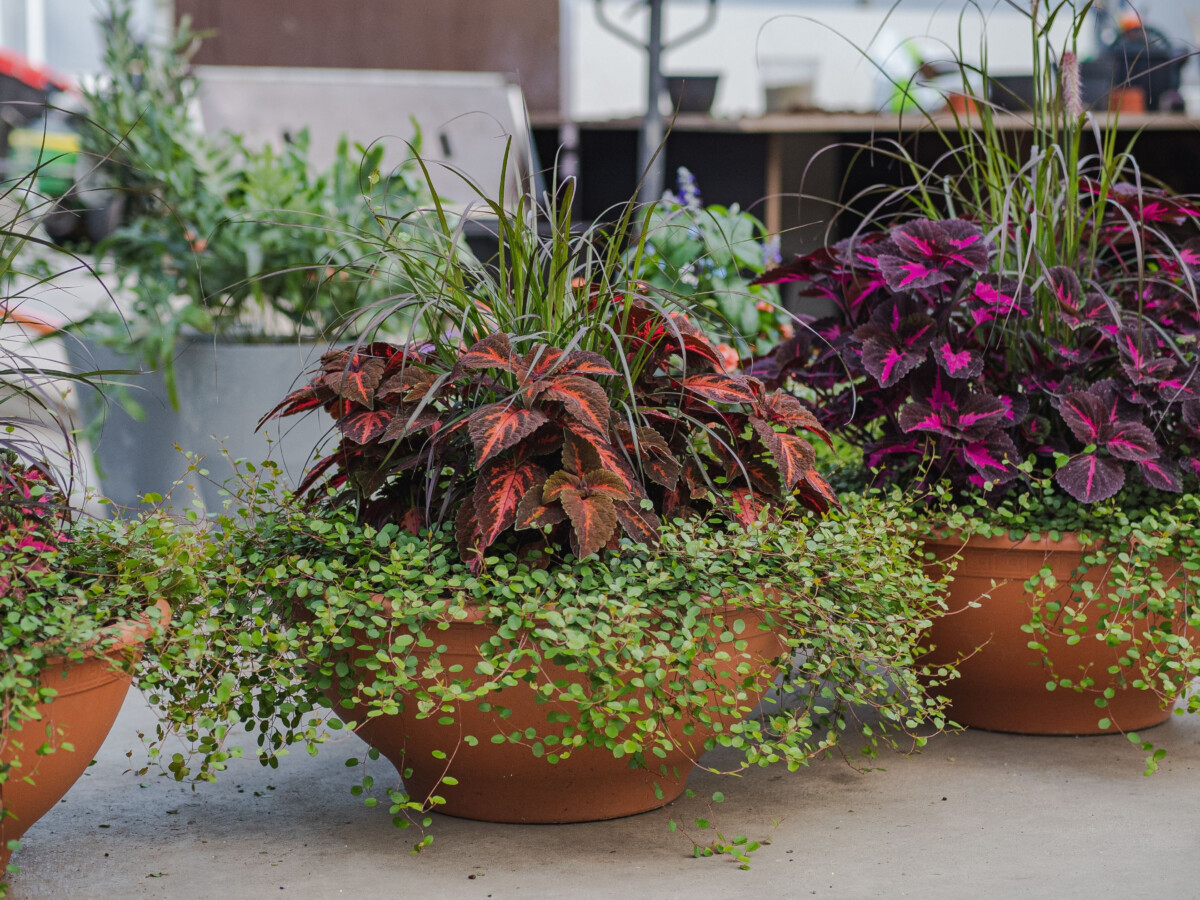
One sound piece of advice when you use spillers such as creeping Jenny, creeping Charlie (both are called Lysimachia) and glechoma is to make sure that they don’t escape into your garden. Growing them in containers is perfectly fine.
Lime tower: Canna, coleus, sweet potato vine and grasses.
Let’s say my warning above about the “creeping family” left you a bit reluctant to use them in container arrangements. Let’s have a look at some substitutions. We keep the grasses and the coleus, then replace the delicate fillers with something that has a bit more body (and a lower chance of taking over your garden). Enter the sweet potato vine, an ornamental classic spiller plant that comes in different shades of green and purple.
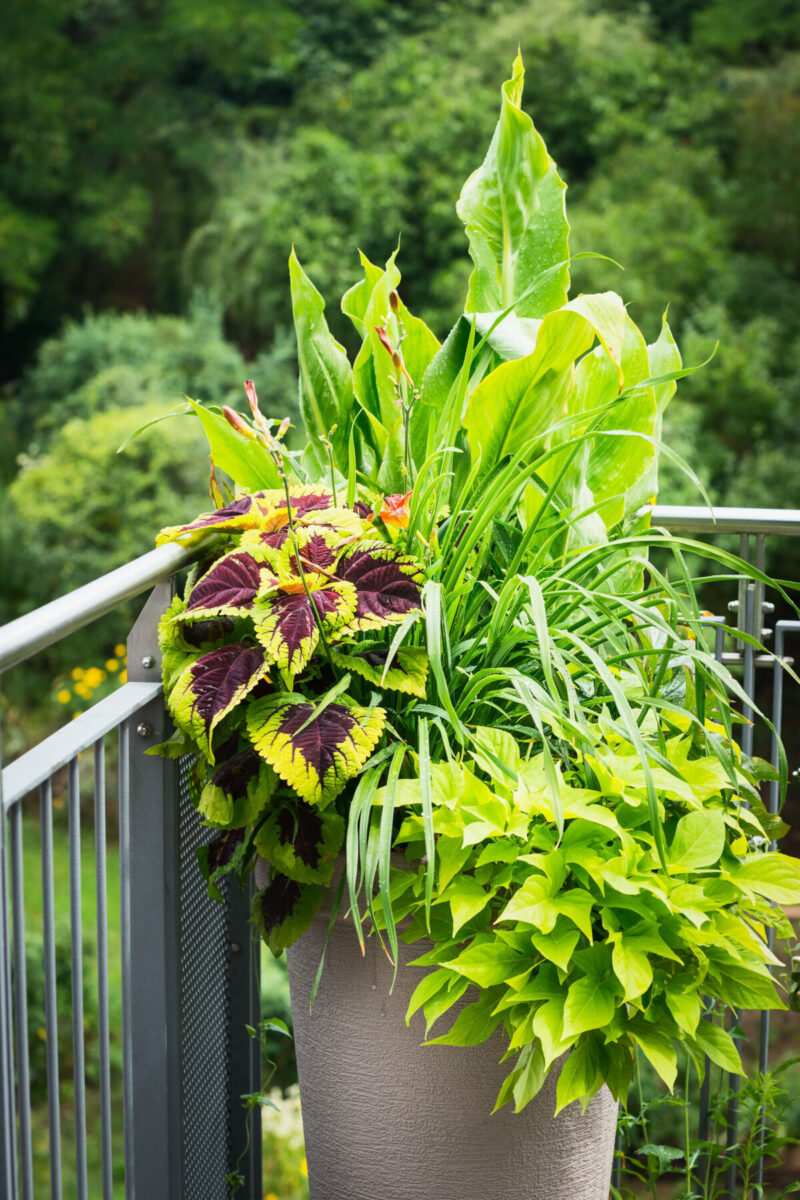
And since we’re just relying on different types of foliage to carry the weight of this design, how about we introduce a flowering plant? The horizontal space is already filled, so the only way to go is up by adding a tropical canna lily with matching lime-colored leaves. This canna will flower orange and in a few weeks it will soften the burgundy red pattern of the coleus foliage.
Elegant simplicity: Tubular grasses, oxalis and spillers.
I took this photo at a public garden in Pittsburgh because I wanted to remember the elegant simplicity of this three-plant container combination.
Tubular grasses, such as young Cyperus umbrella grass (also known as papyrus) make an excellent backdrop for the display. But the filler is an unexpected ‘Green Lucky Shamrock’ (aka Oxalis) that blooms in a sea foam of white flowers.
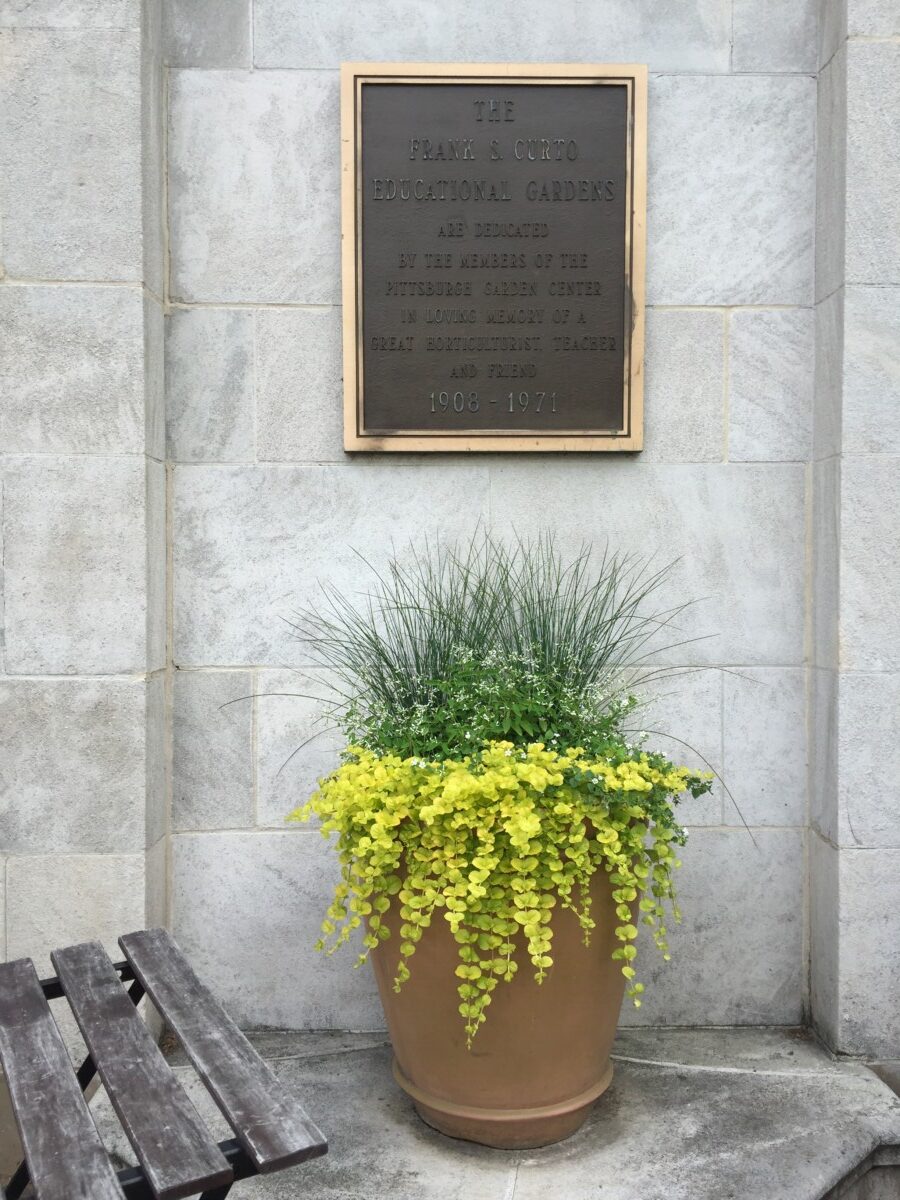
I am partial to a purple oxalis or the ‘Iron Cross’ cultivar, but I must admit that the green one in bloom is just as stunning. The delicate white flowers almost look like they’re floating above the foliage (bonus point, the flowers are also edible).
The spiller is the classic creeping Jenny (Lysimachia); but this time, it’s a golden cultivar called ‘Aurea’ to tone down the bright green oxalis foliage.
Big, bold, beautiful: Impatiens, oxalis and anise hyssop.
This is the purple oxalis that I mention above in all its glory. The plum-colored foliage is spectacular in its richness, especially so when it’s contrasted against the lime-yellow freshness of the Acorus gramineus grasses (the same ones I used in this sensory container display).
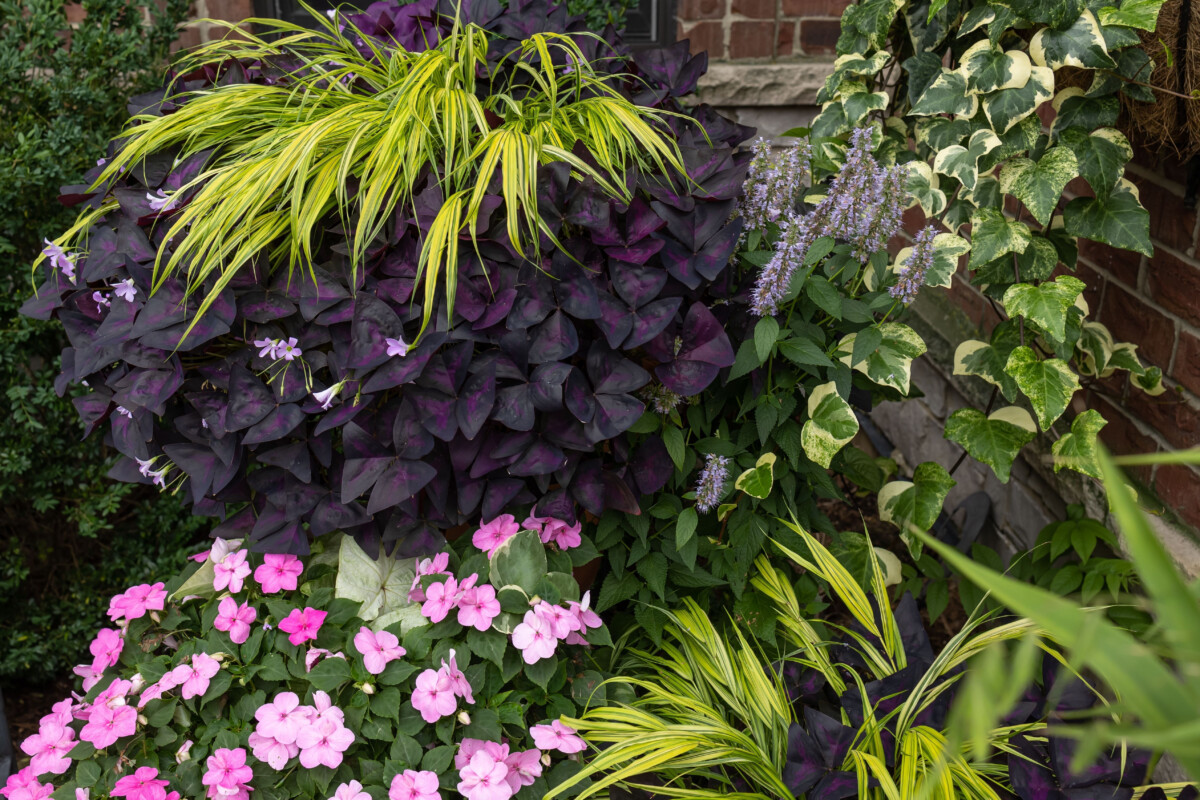
The anise hyssop (Agastache) in bloom is surreptitiously making its way out of the same pot. But perhaps the stars of this vignette are the gorgeous flowers of the pink Busy Lizzy (Impatiens walleriana). They might not be in the same pot as the oxalis, but then again, you can’t force two queens to share a throne.
5 Plant Combinations for Fall Containers
Fiery redheads: Dahlias and blanket flowers.
I didn’t know whether I should put dahlia container combinations on the summer list or on the fall one. But for me, dahlias really come into their own in early fall. With so many dahlia cultivars on the market, it’s now easy to find suitable ones for containers.
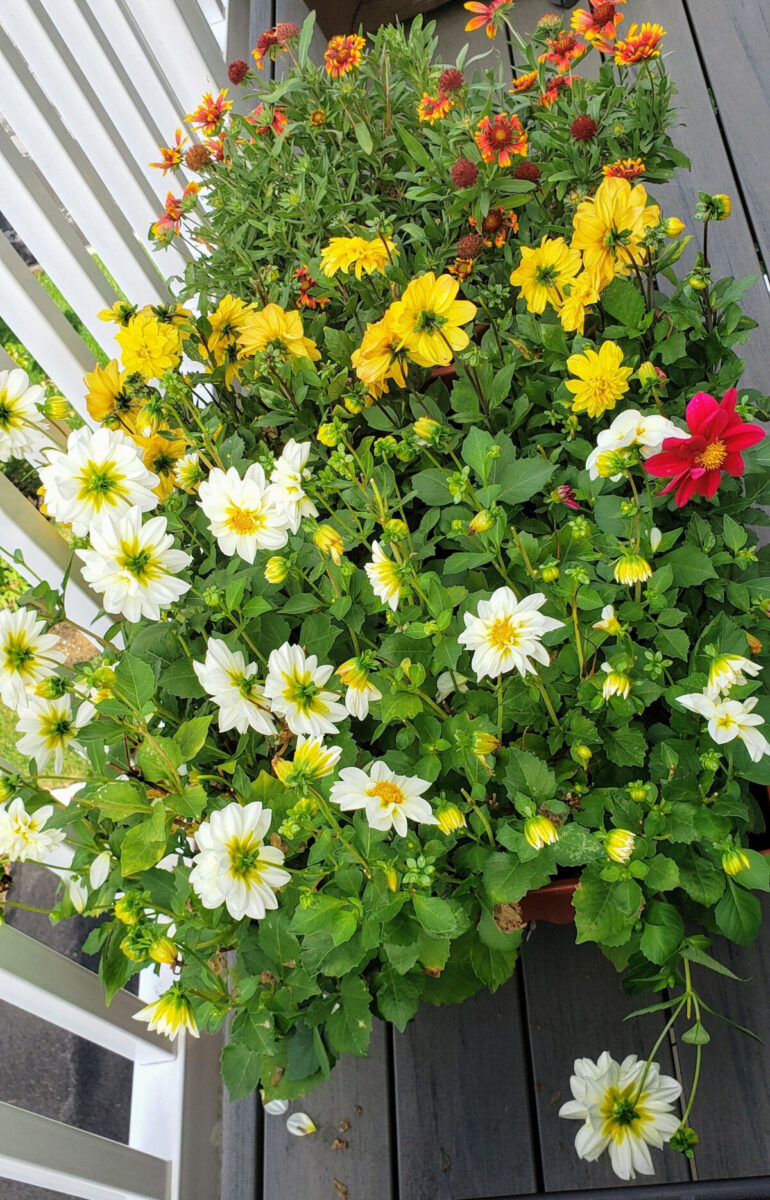
In this article about starting dahlias in pots, I was telling you about ‘Freya’s Sweetheart’ and ‘Impression Festivo’ that are very much suitable for containers. Or you could stick to single-color dahlias and mix them with blanket flowers in bloom (Gaillardia) for an extra dose of heat. Yes, there’s a definite fall color palette here.
Autumn sunset: Marigolds and purple alyssum.
Fall container arrangements are all about bold colors. The deeper the shades, the more visual impact they have. So by combining these tall marigolds with a sweet alyssum underplanting, you’ll get not only a stunning color combination, but also an interesting mix of textures.
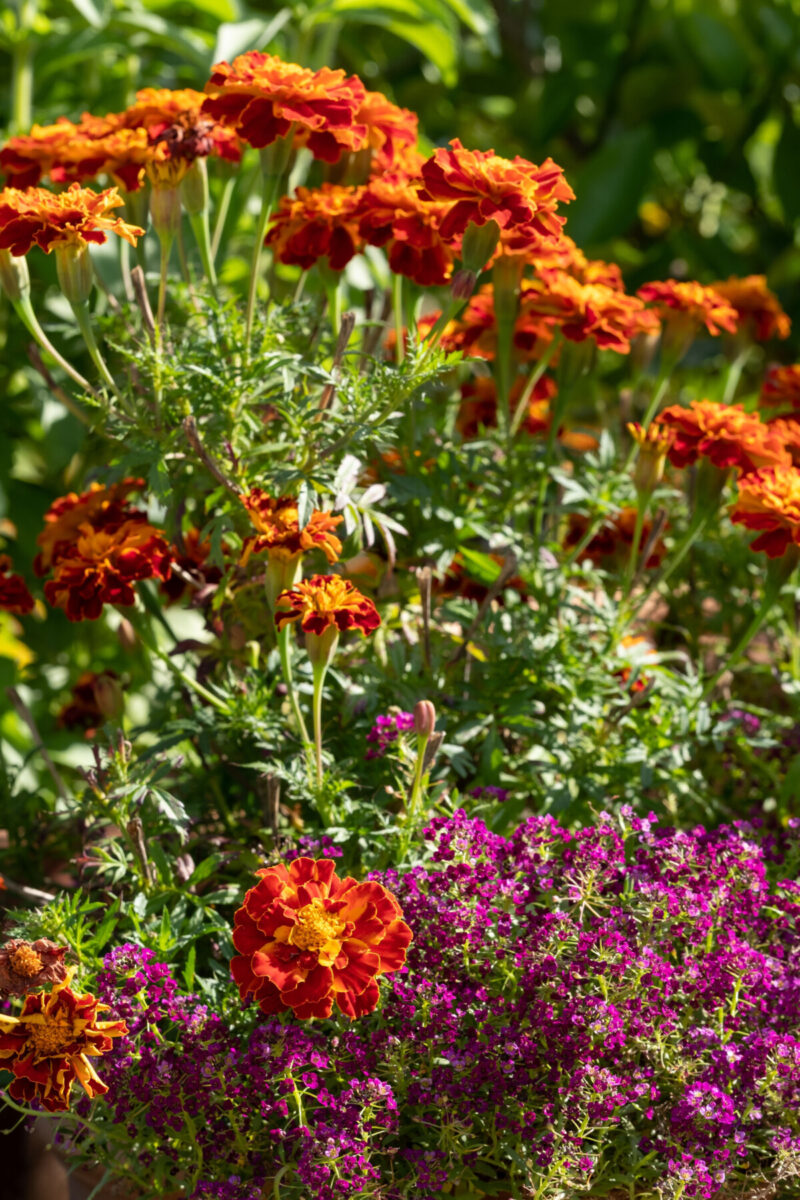
Don’t be discouraged that these two plants are annuals. They’re both long-blooming (even when they spend their lives in pots); as long as you plant them in early September, you’ll be able to enjoy them for a couple of months.
Wispy baskets for small spaces: Marigolds, dahlias and verbena.
Let’s say you only have a small space to play with, such as a balcony, a patio or a terrace. These spaces don’t usually get too much natural, especially if you’re sandwiched in between other buildings. They’re tricky to work with, but not impossible, as long as you keep your expectations in check. So rather than chasing those elusive bloom counts, maybe you can find it in your heart to go for a more ethereal look.
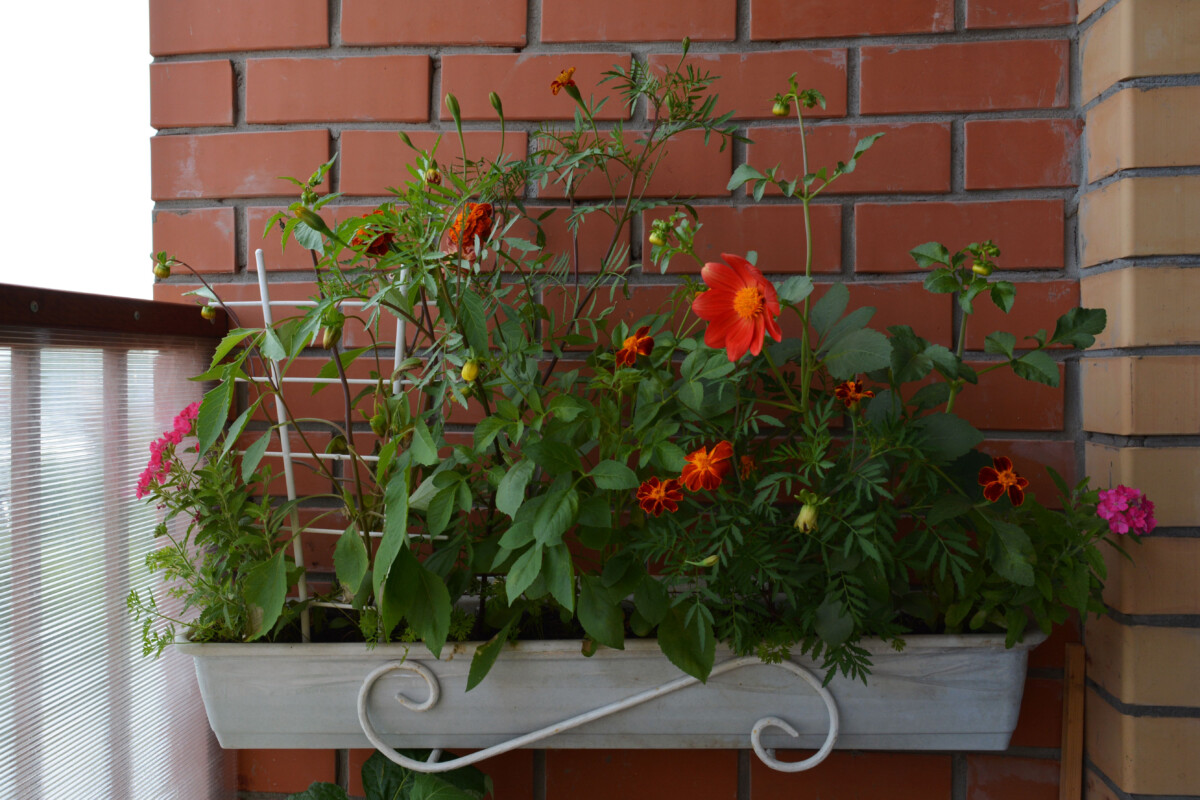
Wispy miniature dahlias, marigolds and verbena (Verbena rigida, not Verbena bonariensis) make a charming annual display. And at the end of fall, all you have to do is bring the entire basket indoors to overwinter, then put it back on the wall after the last frost has passed the following year.
Halloween mood: Ornamental kale, pearl millet and mums.
There’s a lot to unpack in this Tim Burton-esque container arrangement. Creepy pumpkins? Check! Giant ornamental brassicas? Check! Chrysanthemums? Check!
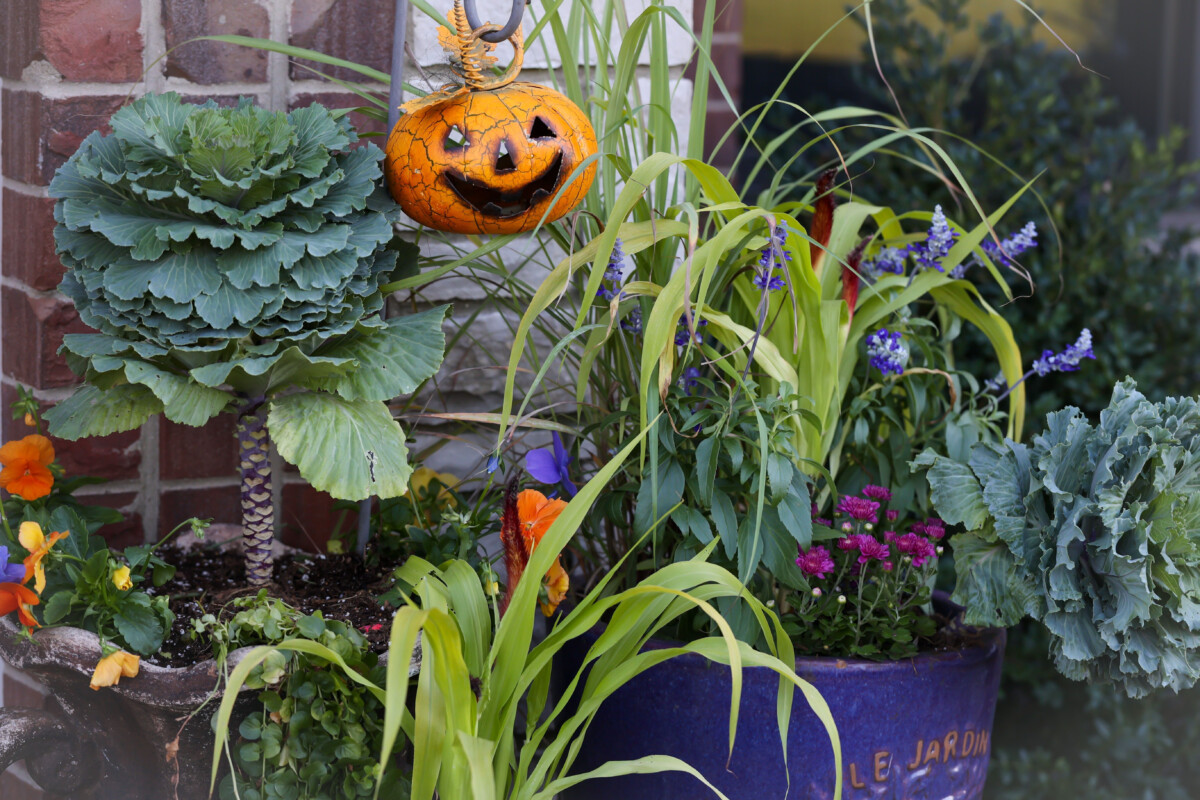
But did you notice how there are also a few elements that bring this weird arrangement back to earth? The delicate false indigo (Baptisia) and the cheerful orange pansies change the mood of this container. And the cascading pearl millet grasses (Cenchrus) soften the lines even further.
A statuesque mix: Cattail, kale and hot peppers.
Mixing edibles and ornamentals is both beautiful and practical. You can plant an edible variety of hot peppers, and you can even nibble on the young leaves of the brassica plants. As for the purple pearl millet (Pennisetum glaucum), sometimes called cattail, this variety is better treated as an ornamental. That means that it has been selectively bred for its striking deep plum foliage rather than high crop yield.
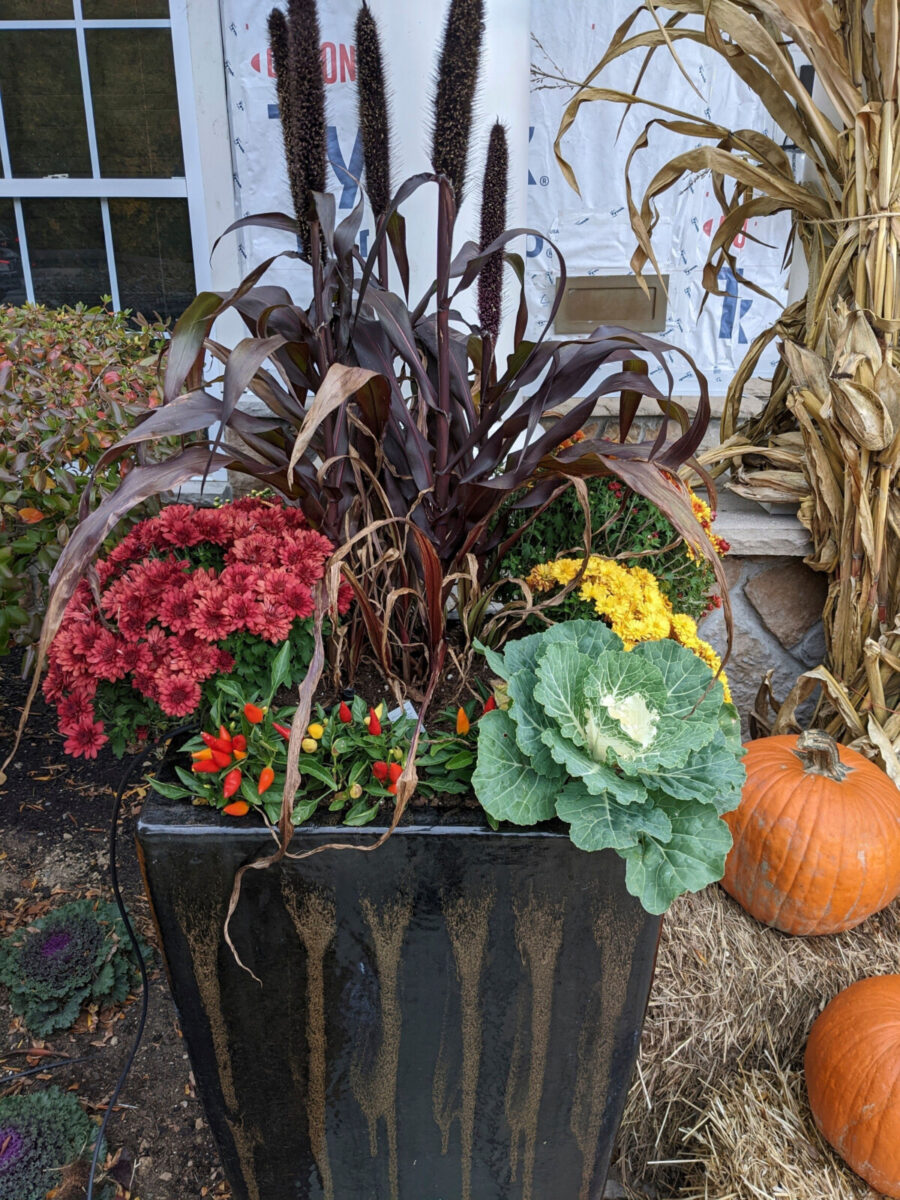
Add a few chrysanthemums in matching shades of burgundy and rusty yellow and you’re all set for a harvest feast.
5 Ideas for Winter Container Gardens
Fuchsia beats gray: heather, cyclamen and cypress.
If you think there’s very little to work with in winter, plant-wise, allow me to contradict this notion. For instance, heather and cyclamen are two mid-winter plants that will just burst into color in glorious defiance of this gray season. If you use some moss to retain moisture around the roots, you can even bring this container indoors for a few days around the holidays.
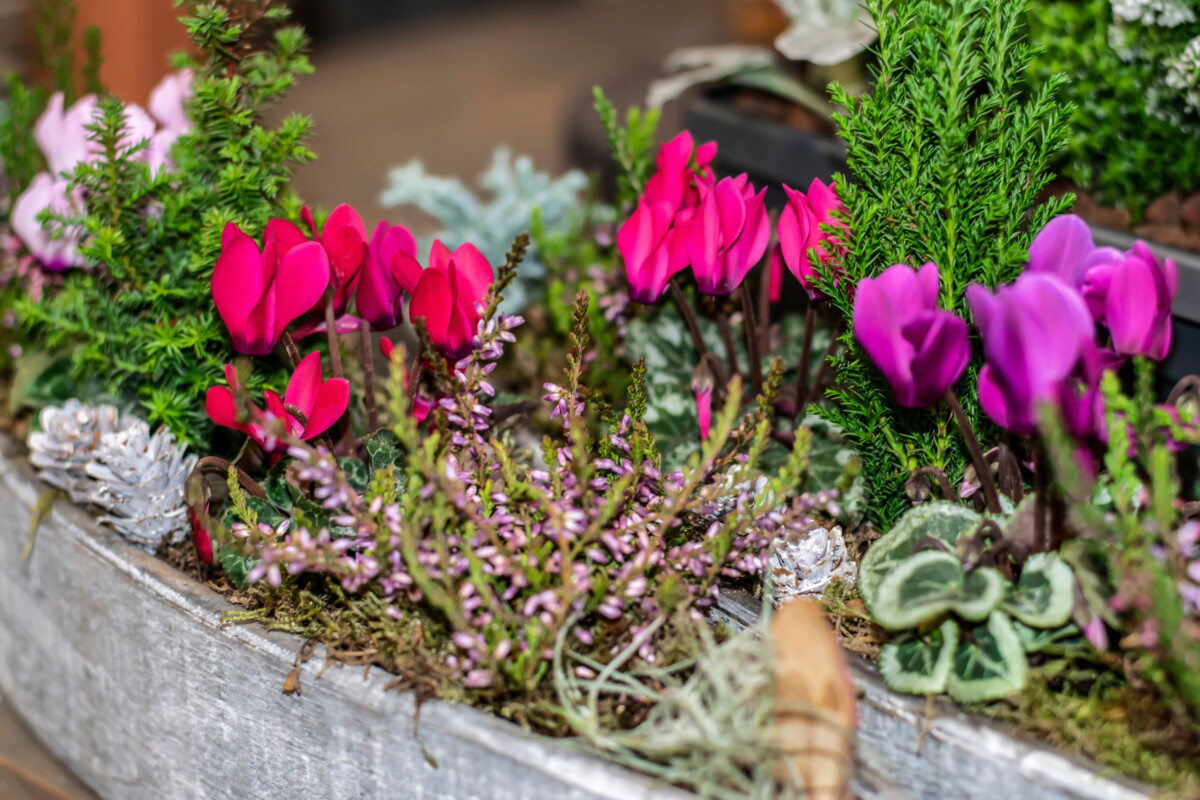
You can keep it simple, or add a hint of a Christmas tree shape by inserting a few tabletop cypress trees in the arrangements (Cupressus macrocarpa ‘Goldcrest’).
Winter wonderland: Coral bells, cushion bush and wintergreen.
It would be very bad form to write an article about plant combinations for containers and not include any coral bells (Heuchera). Coral bells are a gardener’s secret weapon. You can find them in a myriad of colors (their foliage is the main attraction) and they hold their shape very well from summer to winter.
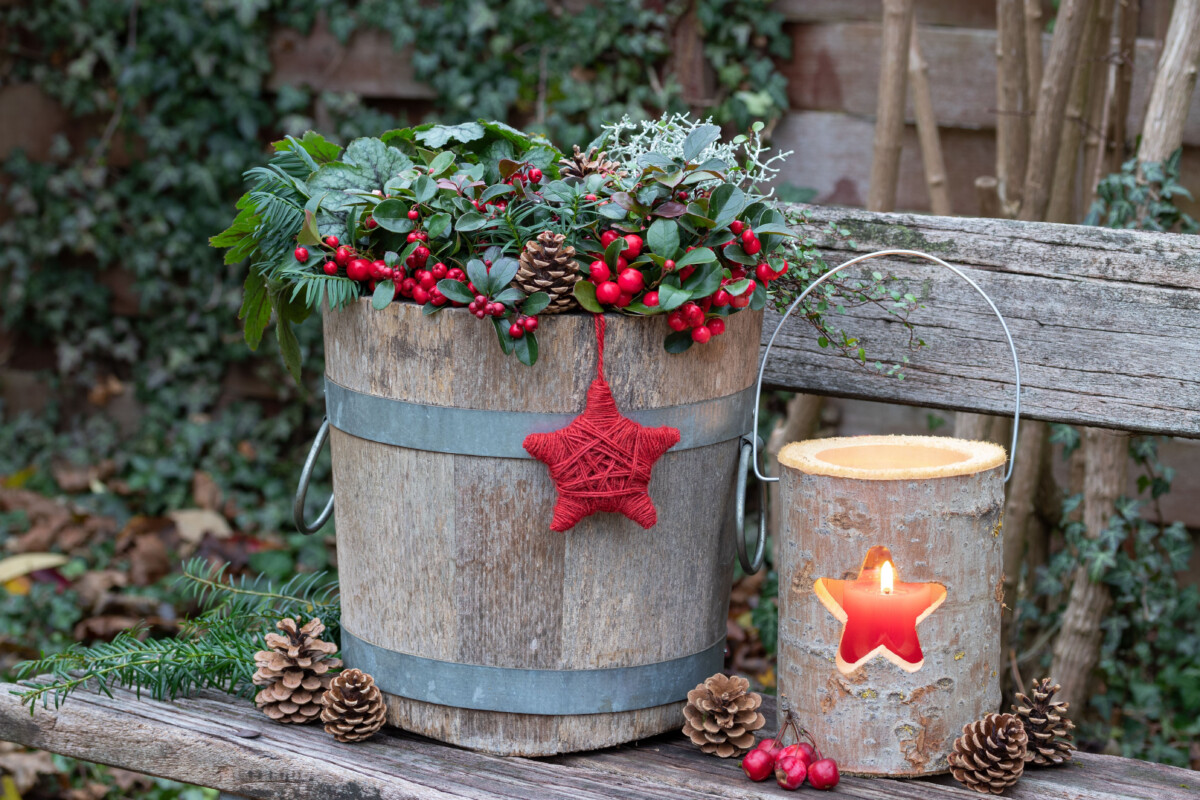
For this particular barrel garden display, you can combine a dark green Heuchera with a silvery cushion bush (Leucophyta brownii), a small shrub in the daisy family that can spend its whole life in a container.
And just to dial up the winter wonderland factor, add a small wintergreen (Gaultheria procumbens) complete with berries. This evergreen, native to North America, goes by a host of other common names. So you may know it as a ground berry, spiceberry or winterberry. When winter is over, you can transplant the wintergreen into the garden, or simply let it grow in a larger container all summer long. If you decide to relocate it, make sure that you plant it into acidic soil.
A barrel of fun: Skimmia, cypress and ferns.
I see Japanese skimmia a lot in winter arrangements and even in wreaths. Its sweet-scented flowers eventually turn into raspberry-colored berries (not edible). But it’s the evergreen foliage that makes it perfect for winter container gardens. If you don’t have enough space for a skimmia shrub in your garden there are tabletop varieties that pack a colorful punch.
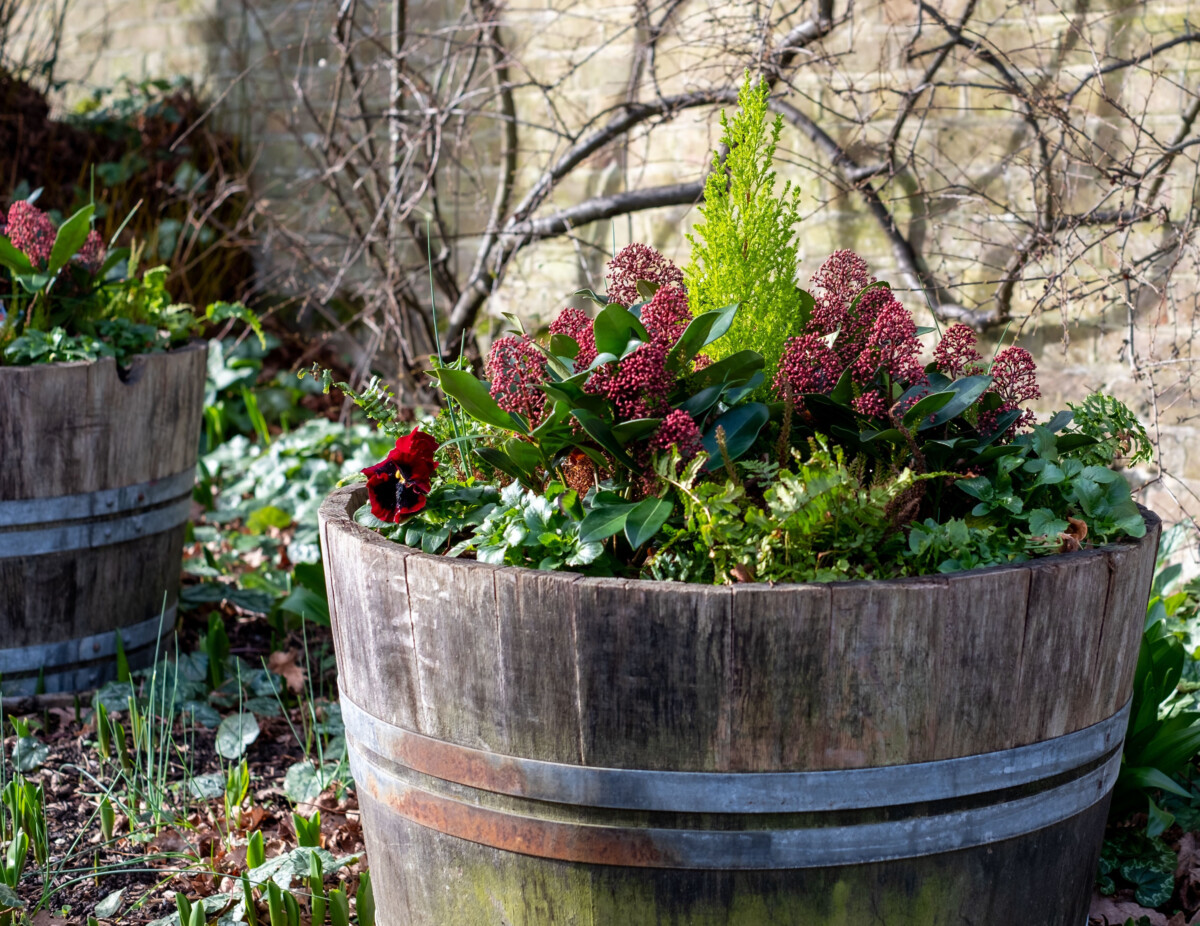
The chartreuse cypress (Cupressus macrocarpa ‘Goldcrest’) makes another appearance as a Christmas tree stand-in, while the small fern underplanting adds to the evergreen charm.
Winter classics: Hellebores and cyclamen.
I showed you a winter container arrangement mixing cyclamen with heather, so it’s only fair to bring the other winter darling into the equation: the humble hellebore. A chorus line of cheerful cyclamen snuggle together under the watchful eye of the statuesque hellebores. What more could you want to warm up a cold winter day?
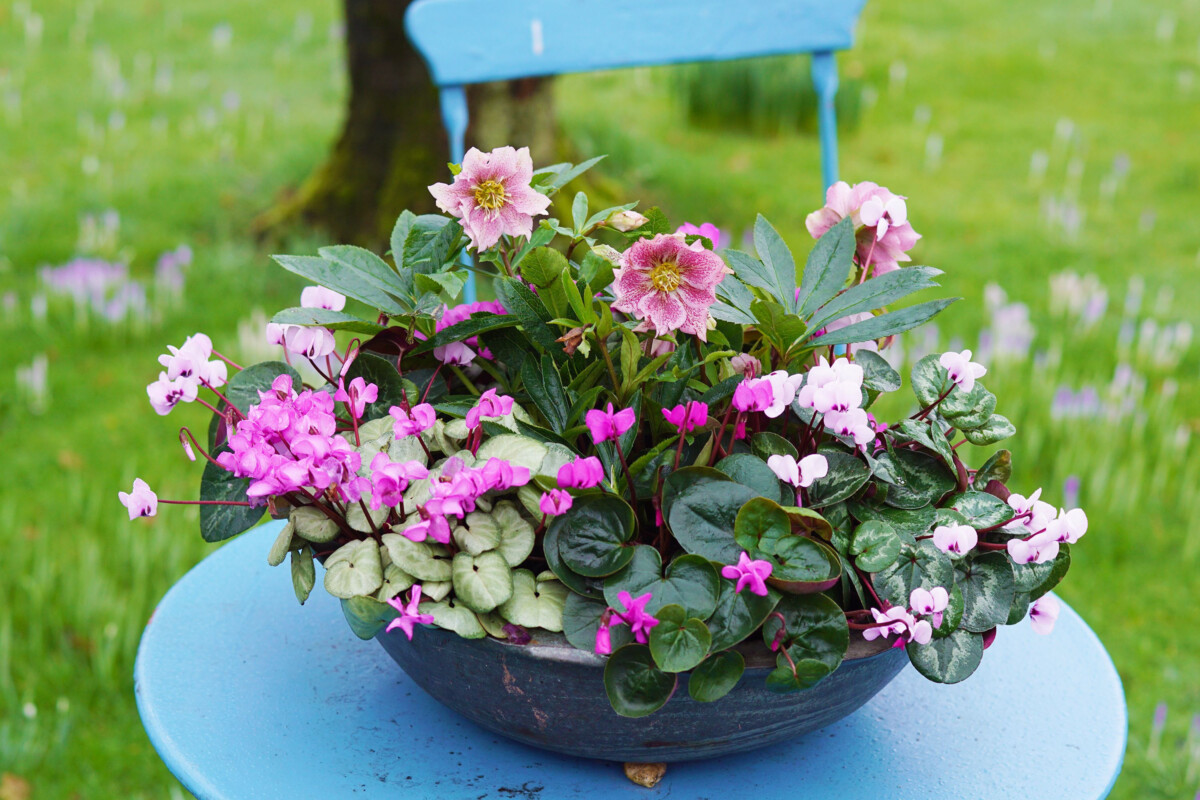
The cyclamen will continue to flower as long as you deadhead them regularly. If you’re a fan of this cheerful winter staple, have a look at this article I wrote about keeping cylamen as houseplants and helping them bloom again year after year.
A modular design: Daffodils, cordyline and English ivy
I don’t know about you, but by the time February rolls around, I could definitely do with a boost of color. Especially warm colors. And if purple-ruby is the domain of royals, then this cordyline is nothing but a queen. An understated one that doesn’t make too much fuss. Couple it with delicate Tete-a-tete narcissi and a splash of evergreen ivy and that’s all you need to brighten up a winter day.
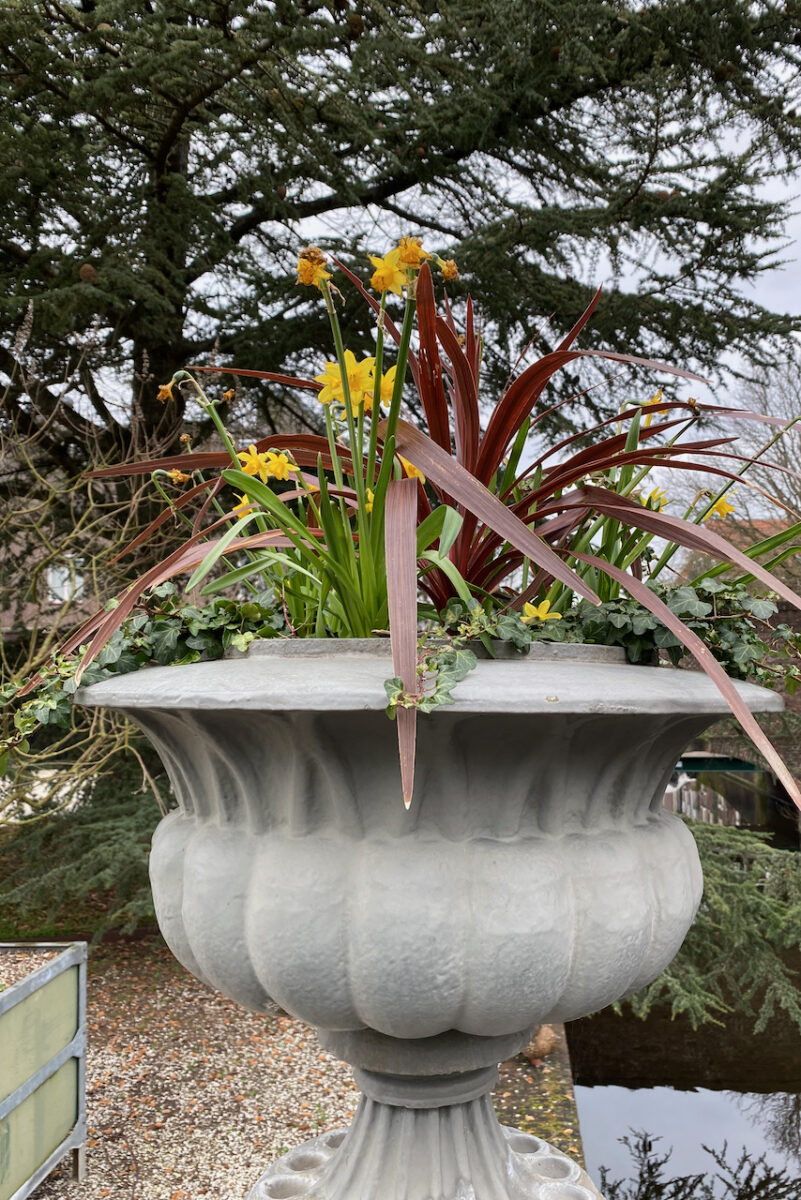
I called this a modular design because you can easily switch up one element every season. When the flowers of the daffodils are spent, you can plant snapdragons and miniature lupines (for a summer display) followed by pom-pom French marigolds in the fall. The cordyline and the English ivy will hold down the fort throughout the seasons.
If you want to dig deeper into designing container gardens, I highly recommend reading the book Container Gardening for All Seasons by Barbara Wise. She creates next-level container arrangements for her clients. Be warned, the container arrangements featured in the book are quite large, but also very spectacular.

